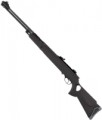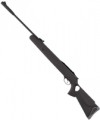Cocking system
The type of cocking system provided in the design of the rifle.
The cocking system is responsible for setting the trigger mechanism to the combat cocking position (ready to fire), and in the case of a multi-shot design, also for feeding the next bullet into the chamber. Such systems are usually divided by the control method. The options encountered today include, in particular,
a barrel break, a lever (
side or
under-barrel),
a pump mechanism,
a bolt(including such varieties as
biathlon and
bolt), and
an automatic cocking system. Here are the main features of each of these systems:
— Barrel break. In rifles with this type of cocking, the barrel is fixed on a rotary axis, and folds down with each reload. In this case, not only the trigger mechanism is cocked, but the chamber also opens, allowing you to load the next bullet. This option is found exclusively in spring models - conventional and with a gas spring (see "Type"), it is with such rifles that the barrel break is most compatible. One of the key advantages of such systems is their low cost. In addition, "breaks" are very easy to use, do not require special skills and are suitable even for inexperienced shooters. So such pneumatics
...are extremely popular these days. At the same time, they are usually made single-shot (with very rare exceptions), constant folding and unfolding of the barrel can be quite tedious, and the barrel mount tends to loosen as it wears out, which reduces accuracy and power.
— Automatic cocking. Systems that do not require any additional actions from the shooter to cock the weapon; found in PCP pneumatics (see "Type"), gas-cylinder models, and AEGs (the latter are by definition made only with automatic cocking). In accordance with the name, the cocking in such weapons is carried out automatically before each shot - as a rule, with the next bullet being sent into the chamber (although there are also single-shot models where the bullet must be inserted manually). In any case, the automatic cocking is extremely simple and easy to use. In addition, even fully automatic weapons can be created on the basis of such mechanisms (see "Automatic mode"), although most rifles with this feature still operate in the single-fire format. The disadvantages of such systems include the complexity of the design and the rather high cost, as well as the fact that air/gas is additionally consumed for the automatic cocking. This reduces the number of shots per charge, and can also reduce the initial velocity compared to similar models with manual reloading (however, the latter is typical mainly for gas-cylinder rifles).
— Under-barrel lever. Systems that use a lever under the barrel, which must be pressed down with each cocking. Like the barrel break described above, this method is used primarily with spring-piston mechanisms and gas springs. It is more convenient and reliable, since the rifle barrel remains stationary at all times, and its design does not include fasteners that can become loose and fail. On the other hand, the lever design is noticeably more complex and expensive than the break-action design, and therefore is quite rare.
Note that the pumping lever in multi-compression models (see "Type") is usually not responsible for cocking the weapon, so a different cocking method is specified for such rifles (although there are exceptions). And in gas-cylinder models, there is a special type of under-barrel lever - the so-called Henry bracket, like in classic cowboy Winchesters (in fact, such pneumatics usually just copy this weapon).
— Side lever. Systems that use a lever on the side of the rifle — usually on the right. They are found mainly in models with a spring-piston mechanism or a gas spring. As in the case of an under-barrel lever, the main advantage of this method is the immobility of the barrel, which contributes to accuracy and reliability. On the other hand, such a cocking system is usually made for right-handers and can be inconvenient when shooting from the left shoulder; in addition, a side lever is somewhat more difficult to fit into a design than an under-barrel lever. Therefore, this option has not become very popular.
— Bolt. Systems using a classic type of bolt handle — sliding back and forth. This type of cocking does not provide air pumping, and therefore is used only in gas-cylinder rifles, PCP, and some multi-compression models (see "Type"). Pneumatics with bolts are mainly made multi-shot — this is the very idea of such systems (feeding the next bullet from the magazine); however, there are exceptions. In general, this is a fairly simple, practical and reliable method of cocking, but nowadays more specific types of bolts are increasingly used — biathlon and bolt; they are listed separately in our catalog and described below.
— Biathlon bolt. A type of bolt (see above), copied from small-caliber biathlon rifles. In such systems, as in traditional bolt mechanisms, the cocking handle is located on the side and moves back and forth. The key difference is that this handle is fixed on a rotating mount and does not slide along the guides when reloading, but swings on the axis. The biathlon bolt differs from the similar in design side lever (see above) in its location (at the rear of the rifle), shorter lever length, and the fact that it does not provide air inflation. Many shooters consider this bolt more convenient than the classic one — in particular, it has a very small operating force, due to which you can move the lever without taking your eyes off the sight. And in some models, you don’t even need to remove your “shooting” hand from the handle to cock the bolt — just hook the lever with your index finger, pull it towards you with a light movement of the wrist, and then, if necessary, move it forward with your thumb. The biathlon bolt is used almost exclusively in PCP rifles (see "Type").
— Bolt action. A type of bolt (see above) that not only moves back and forth when reloading, but also rotates around its axis — similar to how it happens in many classic firearms like the Mosin rifle or Remington 700. In fact, the resemblance to real weapons is one of the key advantages of such systems: they are valued by fans of traditional rifles, and can also be good training simulators for developing basic shooting skills from more serious "bolt" weapons. Most pneumatics with such cocking systems are PCP or gas-cylinder, only a few models use the multi-compression principle (see "Type").
— Pump mechanism. Systems in which a movable fore-end is used for cocking — as in pump-action shotguns, hence the name. The main convenience of such systems is that cocking can be done without removing your hands from the weapon. On the other hand, the constant movement of the fore-end throws off the sight and has a negative effect on accuracy, so this cocking method is not particularly popular in air rifles.Fuse
The type of safety provided in the design of the rifle.
Recall that the fuse is a device that prevents an unwanted shot. In air rifles, such a device can be
automatic or manual, and in some models it is absent altogether. Here are the features of each option:
— Manual. Fuse, switched on and off exclusively manually, at the will of the shooter. The most common variety — such mechanisms are as simple and inexpensive as possible. They are somewhat less safe than automatic ones (see below) and require more careful attention; however, it is not difficult to develop the skill to properly handle the manual safety. And in multi-shot models, the advantage of manual safety over automatic is that there is no need to make unnecessary actions between shots.
— Automatic. A fuse that, at a certain moment, works automatically, without additional actions on the part of the shooter. Most often, such systems operate in this way: the weapon automatically becomes on the safety lock after the trigger is cocked, and in order to make a shot, you must first turn off the safety lock manually. This provides more safety than in the manual systems described above: if the shooter forgets about the fuse, the shot will not happen anyway. Particularly popular are automatic safety locks in cocked rifles due to a broken barrel (see "Cocking System"): such a mechanism does not allow you to pull the trigger until the shooter has completed relo
...ading. But in other types of pneumatics, this option is rare.
In addition, this category may include systems that are not fuses in the original sense of the word — for example, a mechanism that prevents the bullet from feeding into the chamber of a PCP rifle (see “Type”) if there is already a charge there.
— Is absent. No separate fuse. A similar design is found in two varieties of air rifles. The first is low-cost models with a spring principle of operation (including those with a gas spring; see "Type"). In such models, the fuse is abandoned solely to simplify and reduce the cost of construction; it is worth buying such a rifle only if the future owner knows the safety rules when handling weapons.
The second type of pneumatics without fuses are high-end PCP rifles designed for professional shooters. Similarly, the role of the "fuse" when using such weapons is played exclusively by the skills and experience of the user himself.Barrel length
The working length of the rifle barrel is from the chamber where the bullet is loaded to the muzzle. The shortest barrels found nowadays have a length
of just over 200 mm(and in some AEGs even
less than this value); the longest reach
500 – 600 mm.
There is a stereotype that the muzzle velocity directly depends on the length of the barrel. In firearms, this is true — but not in pneumatics. Firstly, in such rifles, the initial velocity depends on a number of other indicators — pressure, the quality of the barrel treatment, the efficiency of the valves, etc. on the first 20 – 25 cm of the barrel, then the gas pressure drops noticeably. The exception is PCP rifles, in which the longer barrel really makes it easier to achieve high speeds. However, again, so many additional factors affect the final result that models with the same barrel length can differ markedly in initial speed.
The second common stereotype is that a longer barrel improves accuracy and accuracy. This is true in the context that a longer barrel allows for a greater distance between the front and rear sights, making it easier to aim carefully. Technical accuracy does not depend on the length, but on the quality of the barrel processing.
Summing up all of the above, we can say that the length of the barrel for an air rifle is more of a reference than a really significant paramete
...r, and when choosing, it is better to focus on more "close to life" characteristics — first of all, directly claimed muzzle velocity.
